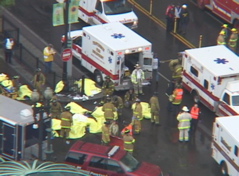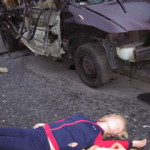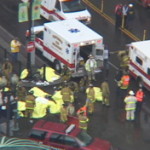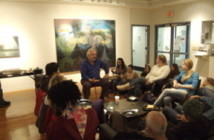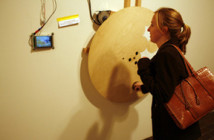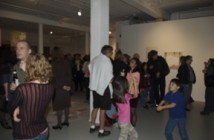On Sunday, October 1st, the Institute for Infinitely Small Things traveled down to Providence to observe the Disaster Drill that was being staged in Kennedy Plaza. This was just one of many Disaster Drills that have been staged throughout the United States, Canada and the U.K.. The Disasters are produced to test the timed response and communications between different federal and state agencies in a variety of scenarios that include bird flu epidemics, disease vaccinations, bombings, and attacks on energy supplies, among other things.
This scenario was a suicide car bomb in downtown Providence. While the actual “Disaster” took place early on a Sunday morning, it was simulating Kennedy Plaza on a weekday afternoon when thousands would have been in the surrounding the area. The Providence Emergency Management & Office of Homeland Security (PEMA), in collaboration with federal and state agencies, produced it.
Participants or The Players
In order to produce such a huge event in the middle of city, there had to be many participants. There were 200 volunteer victims, members of the National Guard, workers from Homeland Security, policepeople, firepeople, and independent evaluators that were flown in from Federal agencies to help make the Disaster happen.
We went to the volunteer center about a mile away from the scene of the Drill and spoke with some of the victims. One man brought his Boy Scout troop to the Disaster to volunteer with the promise that each Boy Scout would earn a badge for his participation. Other people told us they felt they were doing their patriotic duty, or wanted to help in any way they could to insure that Providence would be safe.
Among the many other participants were national guardsman with machine guns, police officers that guarded the perimeter of the Disaster scene, and people in white vests that read OBSERVER in bold black letters on the back. It was a grand operation, and we waited patiently for the Disaster to begin as we watched all of the participants and players prepare for their big performance.
The Drill, Performance and Production Values
The Disaster Drill was crafted out of fears that we have been led to believe are real in our post-September 11 world. In this, the Drill was a grand performance, pulling from our darkest, terrorist-fearing nightmares to produce a spectacular event. Or so we thought. In regards to this performance, the word “grand” can only be used to refer to the size and cost of the production.
The key to producing a believable Disaster Drill (one might imagine) is not only providing performers that are convincing, but also insuring that the props are realistic. It’s the whole shebang. A producer cannot overlook any detail in planning. This is one area where the Providence Disaster Drill did not let us down. We spoke to a former marine now employed by the Department of Alcohol Tobacco and Firearms who had blown up a van in the desert and brought it to Providence to become the simulated terrorist suicide bomber’s van. He told us about his past experience in blowing up vehicles, and explained his process of making the van, which even included making a chart of where the debris from the van had landed after it exploded. He used this chart to place the van debris in its approximate landing locations in Kennedy Plaza.
Sadly, many of the performances in the Drill were not as convincing as the van. After the loud bang representing the start of the Drill went off, volunteer victims wandered in the park across from Kennedy Plaza and huddled under trees to keep out of the rain, making little to no effort to perform their roles as victims. This was especially disappointing because we had observed staff applying makeup to the victims’ faces, which included fake blood and some very impressive latex “injuries” depicting exposed bone, brains and other deep wounds. Each victim had a slip of paper that might say something like “Male 45. You suffered burns and a severe injury to the head. You are disoriented, walking around in circles and calling out repeatedly for help.”
The other dozen or so spectators that interviewed also felt that the performance was lacking, some suggested subplots and love stories to make the drill more entertaining. One woman, who works as a nurse in a local hospital, derided the victims’ performances and reported that her hospital’s disaster simulations did a much better job of actually simulating the emotional and logistical chaos that follows disaster. But in the grand scheme of things, it doesn’t matter that we were unimpressed. After all, the Drill participants weren’t performing for us; they were performing for other people: the workers were performing for their supervisors; the victims were performing for the workers; and so on.
Security or The Culture of Fear
There are several complicated points within this Disaster Drill that provide a departure for thinking about our culture in terms of fear and security.
The area where Drill took place was closed off to outside participants (i.e. the spectators), and only Drill participants were allowed into the Disaster area. There were security people surrounding the perimeter of the closed off area around Kennedy Plaza, creating a space that was controlled and organized, an inside and an outside. For a disaster, this idea of a secure area defeats the purpose; it completely negates the chaos that is an essential part of a disaster under the presumption that practicing for disaster will make us more secure. It is, in fact, this brand of security as control in the Drill that perpetuates insecurity and fear.
In the five years since September 11, we have been flooded with images, narratives and ideas from our media, politicians, and well, almost everywhere. They tell us that we need to be afraid. If many Americans, like myself, have stopped taking the Terror Alert Level warnings seriously; perhaps the Disaster Drill offers up a whole new way to perpetuate fear. I don’t think I’m more fearful of the next big attack than I was before I found out about Disaster Drills, but some of the people that we spoke with did report that they felt “more aware of the threat” and “chilled by the possibility of terrorism here in Providence”. These Disasters actually function as a machine of fear in a very creative way. I would like to propose that we begin a new area of study in performance art: The 21st Century-Government-Produced-Happening, or for short: Disaster Art.
Why? Because these aren’t just drills. That’s misleading. These are full-on theatrical events produced on Federal, State and Local levels. The publicly advertised reason for these Drills may be to test response and communications systems, but they are testing these things in a completely controlled and secure environment. They are supposedly making a more secure nation for us to live in, but with the fake blood and exposed bones—the “injuries” decorating the 200 volunteers, the dummies strewn on the ground, the dead babies propped up conspicuously, the huge effort of blowing up a van in the desert and bringing it in for the Drill, the men with machine guns, the sound of the explosion, the closing down the city center, and all of the other theatrics, it’s hard to believe that the producers behind Providence’s Disaster Drill were merely testing the response of emergency workers alone.
This is why I propose we view these Disaster Drills as performance art. No matter how bad the performers in the drills are, the producers have created a new kind of reality for the residents of our cities and towns. For many people who participated in the drill, specific memories of the performance will be tied to specific places and situations in the city; where the suicide bomber’s van was placed for the drill, where the bloodied dummies were strewn, where the volunteers huddled in the rain. A city, especially an area like Kennedy Plaza, is full of intimate relationships between people and spaces: walking patterns, sitting spots, driving routes, etc. Even if some residents did not witness the performance as a spectator, the mere knowledge of the Drill taking place is enough to have an effect on an individual’s relationship to the city, and in turn, to the greater world.
One of performance art’s best tools is creating frames with which to view our everyday environment in a new way. The Disaster Drill fully succeeds in creating such a frame through the fears that it raises. They go something like this: If the Department of Homeland Security feels that the various kinds of disasters that they are practicing for are so likely to happen that they have to practice for them, then perhaps we should be afraid. If they spend millions of dollars on “practice,” then perhaps we should be afraid. Simulating disasters feeds our cultural imagination of what could happen. This is a careful deployment of fear, backed by the authority of the government, by money and by the power to control public space. This is what makes a work of Disaster Art brilliant and forever memorable.
Overall Review=(3 1/2 Stars)
Overall, given the huge effort that was put into the Providence Disaster Drill, I give it 3 1/2 out of 5 stars. While most of production’s special effects and props were very well done, spectacular even, I would not recommend seeing a Disaster Drill for the mere performance of a disaster. The acting was terrible, which completely ruined the somewhat convincing art production values of the performance.
What we have to remember is that The 21st Century-Government-Produced-Happening is a new breed of performance. Every creative endeavor has its beginnings, and certain kinks within the performance will eventually get worked out. This particular Disaster Drill was relatively low budget compared to Drills that have been produced in Las Vegas, for example, where over 2000 actors were hired to perform as victims, which, in the case of Providence’s Drill, would have helped the performance immensely.
No matter what the budget, I highly recommend attending a Drill, whether it be as a spectator, victim or otherwise. The infinite number of complicated situations that are created by these Drills is enough to breed inspiration for any person, artist or not. It is crucial that that these new performance practices get their due attention; they are brilliant, horrific, genius and are not to be missed.
The Institute For Infinitely Small Things will be accepting reviews of other drills in your area for as long as they are produced. To submit a review, e-mail: disaster.art@gmail.com.
Links:
The Institute for Infinitely Small Things

